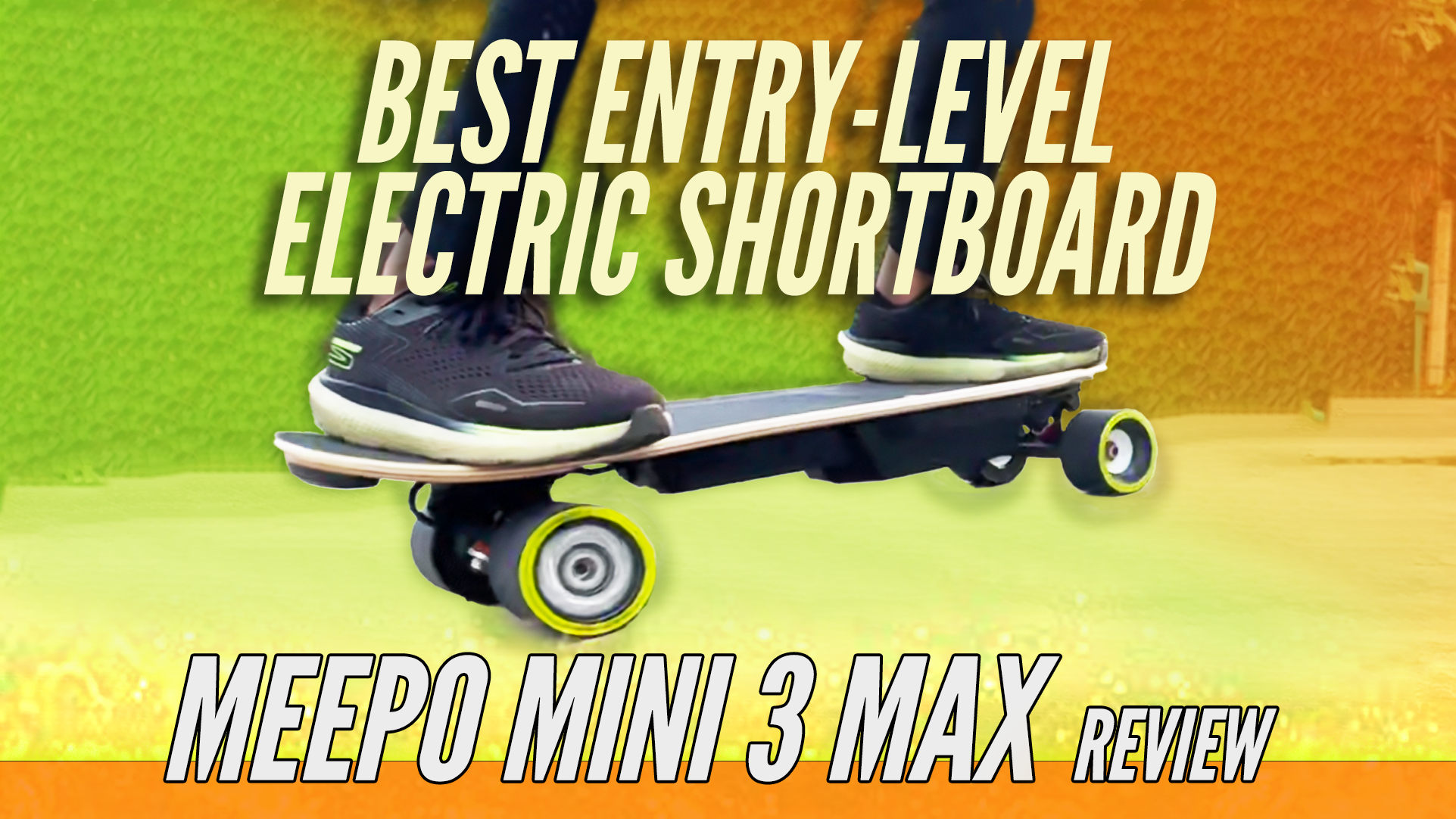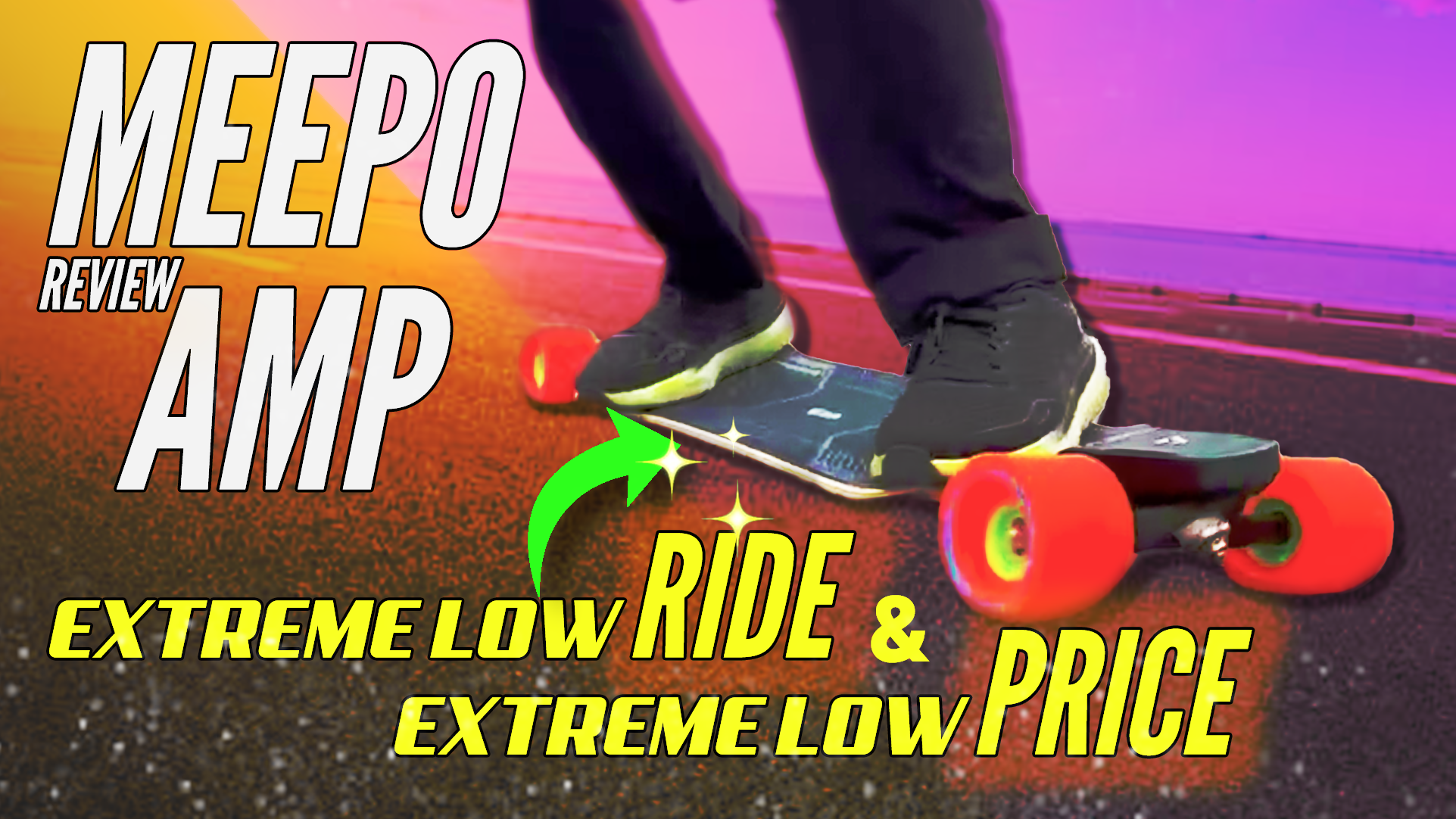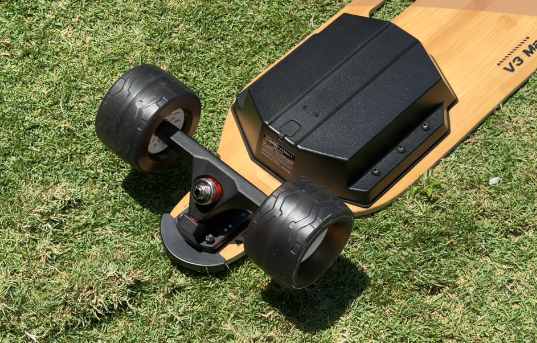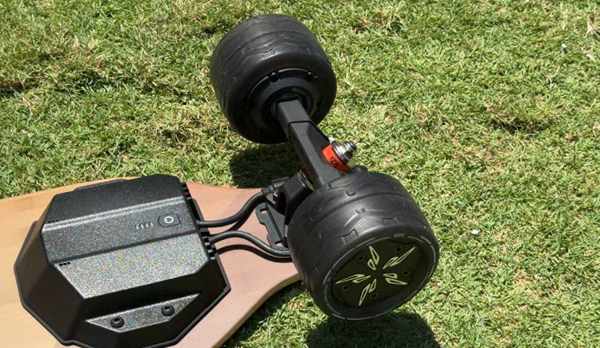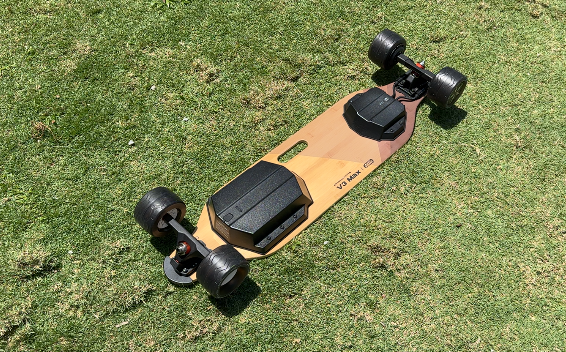The Meepo Mini 3 Max is the shortboard counterpart of the Meepo V3 Max. Both of which are setting the standard that other entry-level electric skateboards—that is, electric skateboards under $500—will be compared to.
Not because using mismatched wheels is fashionable, but because 12s3p boards for $500 is a super amazing deal.
As usual, let’s run through the specs.
Meepo Mini 3 Max Specs:


| Price | $454 (with code ESHQ15) |
| Battery | 12S3P 324WH 7.5AH |
| Controller | LingYi ESC |
| Top Speed | 28 mph (45 km/h) |
| Range | Up to 20 miles (32 km) |
| Deck | 8 ply maple + 1 ply bamboo veneer |
| Motor | 2 x 800W (full magnetic hub) |
| Weight | 19.8 lbs (9 kg) |
Deck – 8 ply maple + 1 ply bamboo veneer:


Starting with the deck, the Meepo Mini 3 Max uses a 30” deck made from 8 layers of Canadian maple with 1 ply of bamboo veneer. It is a stiffer deck with a deep U-shaped concave which helps with board control.
The tail skid pad came pre-installed—something all reputable brands do now.
The kicktail is very easy to engage. Some shortboards are heavier in the front, making it hard to lift the nose, while this Meepo Mini 3 Max’s weight is distributed more toward the tail, making it easier to engage the kicktail. Sometimes we even get into accidental wheelies, though.
ESC – LingYi ESC:


After dabbling with their own JK ESC, Meepo went back to Ling Yi ESC for this year’s entry-level lineup. Ling Yi ESC means the familiar 4 speed modes and 4 brake modes that can be set independently of each other. Which means no smart power-on, but push-to-start, where the board automatically powers on once it starts rolling.
This year’s Meepo also comes with a new color remote, named the M6C Remote, which is simple but fairly nice-looking.
It’s always worth mentioning that this Ling Yi ESC has some new tricks up its sleeves too—it allows advanced customization of each speed mode. So if the Pro mode is too strong for you, you can always tone it down to your liking.
Battery – 12S3P 324WH 7.5AH battery:


Living under the same enclosure is the big 12s3p 324Wh battery pack. I’m going to repeat myself and remind you that 12s3p for less than $500 was unheard of before this. For context, Meepo themselves were selling the Mini Extended Range at $599 previously, and that used a smaller 288Wh battery.
Surveying across major electric skateboard brands, you’ll see that Meepo very intentionally priced this year’s 3 Max models to have the biggest pack in this price range.
This battery is marketed to go 20 miles (32km) on a single charge, and our 165lbs (75kg) test rider managed to hit that riding fast.
Motors and Wheels – Dual 800W Full Magnetic Hub Motors and 94mm + 90mm wheels:



Despite being the smaller brother, the Mini 3 Max uses the same 800W dual hub motors as its longboard counterpart. While motor wattage never tells the full story of a motor’s power, most entry-level electric skateboards have motor wattages below 600W.
The V3 Max was marketed to go up to 28 MPH (45kph), which we had no problem reaching. And the torque was strong; strong enough to convert some belt-drive fans who, prior to this, may have exclusively bought belt-driven boards for more reliable torque.
One inescapable shortcoming of hub drives is how much vibration is conducted up through the stiff motors, though. The slightly meatier 94mm rear wheels didn’t help much, unfortunately, so you’ll have to be okay with that aspect of the ride.
Again, it’s 94mm at the back and 90mm in the front, and we did feel the tilt, but not to the extent of finding it unpleasant.
Meepo briefly considered a 105mm setup, which did improve road vibration significantly, but at the expense of strong torque. So, if you live somewhere with rough roads and can afford to lose some torque, swapping to 105mm wheels is an option.
Trucks – Standard 7-Inch Reverse Kingpin Trucks:


Next, for the trucks, Meepo went with standard 7-inch reverse kingpin trucks with double barrel bushings. There isn’t much to be said about Meepo’s Shredder trucks—they’re pretty good, fairly balanced between responsiveness and stability. Although not as precise as the top-tier branded forged trucks, they’re easy to turn, fun to carve, and stable at top speed. You can’t ask for more from a budget board.
Our Meepo Mini 3 Max came out of the box a little looser than we liked, making it easier to turn but wobbly around the 22 mph (35 km/h) mark, but once we tightened them up a bit, it was all perfectly balanced, as all things should be.
While the front trucks are pretty standard, the back trucks on the 3 Max series are new and improved.
Usually, the back trucks are “press-fit” hub motors, which look like this—they actually rely on a bunch of screws to hold them to the “pseudo truck.”

And now, the back trucks are full axle, which look like this:

While we haven’t heard of any problems with the previous back truck, the new full axle hub motors give us better peace of mind when it comes to mechanical stability.
Riding Experience on the Meepo Mini 3 Max:


As you can see, at under $500, the Meepo 3 Max series dominates the spec sheets with its giant battery, stronger motors, and a more reliable back truck design. And these all add up to a pretty well-rounded riding experience.
Speed control is perfect—perfectly smooth and intuitive. A tad punchier than Hobbywing boards in the highest Pro mode, but this time, nothing is stopping you from going into advanced settings to tune it down. The board is agile and quick to turn. And it’s as powerful as a mid-range belt-driven board.
Verdict on the Meepo Mini 3 Max:


Until the competition catches up, the Meepo Mini 3 Max and V3 Max will remain our go-to recommendation for electric skateboards under $500. In fact, with unmatched specs and a well-rounded ride feel, the Meepo Mini 3 Max is an easy recommendation for anyone looking for an electric shortboard, regardless of budget.
And we predict it will take another big brand with enough muscle to dislodge Meepo from its position as the budget king. I don’t see how a smaller brand can match the build quality and polish of this. While many things in the world may have gotten worse over time, at least budget electric skateboards are getting better.
If you are interested in buying the Meepo, be sure to check out our affiliate discount link here and use code: “ESHQ15” to receive $15 off during checkout.
It will help you get a small monetary discount and help us out too. On top of that, you’ll be tagged as an Electric Skateboard HQ customer and probably be treated better. Cheers!




